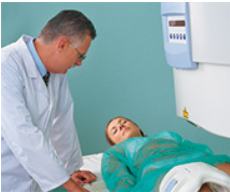
Concept explainers
45-Year-Old Female with Dislocated Hip
In the previous chapter, you met Kayla Tanner, a 45-year-old mother of four who suffered a dislocated right hip in a car accident. Prior to the closed reduction, the doctors noted that her right thigh was flexed at the hip, adducted, and medially rotated. A widened joint space in the postreductionX ray showed that the reduction was not complete, but no bone fragments were visible in the joint space. Mrs. Tanner was scheduled for immediate surgery.

The surgeons discovered that the acetabular labrum had detached from the rim of the acetabulum and was lying deep within the joint space. The detached portion of the labrum was excised, and the hip was surgically reduced. During the early healing phase (first two weeks), Mrs. Tanner was kept in traction with the thigh abducted.
3. There were no bone fragments in the joint space. What is normally found in this space?
Want to see the full answer?
Check out a sample textbook solution
Chapter 8 Solutions
Modified Mastering A&P with Pearson eText -- Standalone Access Card -- for Human Anatomy & Physiology (11th Edition)
- Activity View slides of compact and spongy bone under the microscope. Sketch your observations in the space below. Central canal Osteocyte in lacuna Osteon Osteocyte in lacuna Trabeculae Red bone marrow b) Figure 7.3. Photomicrographs of bone tissue: (a) compact, (b) spongy. Identify the similarities and differences between spongy and compact bone Table 7.1. Comparison of compact and spongy bone. Similarities: Differences: Compact Spongy 2110opanjg oarrow_forwardAHS 131 - Skeletal System - Bone Composition, Structures, Bone Names and their parts. These are the structures and names that you will need to know for your AHS 131 Bone Lab Exam. Please review and rewrite the names in the space below. When appropriate include the function of the structure. Intervetebral Foramen - Spinal Nerve Vertebral Canal - Spinal Cord Normal Curves Lordosis Кyphosis Abnormal Curve Scoliosis Rib Cage True Ribs (1 to 7) False Ribs (8 to 12) Vertebrochondral Ribs (8 to 10) Floating Ribs (11 to 12) Ribs Head Neck Tubercle Angle Body Sternum Manubrium - Jugular Notch - Clavicular Notch Body Xiphoid Process Clavicle Sternal End Clavicular End Conoid Tuberclearrow_forwardA 10-year-old boy came into the emergency room with a painful knee joint. He had full range of motion but was in pain. The attending physician suspected a fracture and ordered an x-ray examination. What was the purpose of the x-ray evaluation? (Do not forget the epiphyseal growth plate.)arrow_forward
- QUESTION 2 Identify the bone and the bone marking the arrow is pointing to in the image. os coxa; acetabulum os coxa; iliac crest O scapula; spine O scapula; glenoid fossaarrow_forwardThe proximal radioulnar joint ________. is supported by the annular Ligament contains an articular disc that strongly unites the bones is supported by the ulnar collateral ligament is a hinge joint that allows for flexion/extension of the forearmarrow_forwardBoth functional and structural classifications can be used to describe an individual joint. Define the first sternocostal joint and the pubic symphysis using both functional and structural characteristics.arrow_forward
- The pelvis ________. has a subpubic angle that is larger in females consists of the two hip hones, but does not include the sacrum or coccyx has an obturator foramen, an opening that is defined in part by the sacrospinous and sacrotuberous ligaments has a space located inferior to the pelvic brim called the greater pelvisarrow_forwardCondyloid joints ________. are a type of ball-and-socket joint include the radiocarpal joint are a uniaxial diarthrosis joint are found at the proximal radioulnar jointarrow_forwardEvan is 25 years old. Would you expect to find synchondroses at the ends of his femur? Explainarrow_forward
- Case Scenario based upon Skeletal Joints: Leanne, age 48, jumped on her niece's hover board, only to be thrown off quickly. As a result, she separated her right shoulder at an articulating point. An articulation is where two bones come together, otherwise, called a joint. A joint can be defined as the location where two bones come together allowing movement. What is the most commonly separated joint in the shoulder - name the joint and the two bones that articulate? What surrounding tissues might also be damaged? How will the inflammation affect Leanne? What is the difference between a separation and a dislocation? If Leanne had suffered a dislocation, what joint would this be and the bones involved?arrow_forwardMatch the term in column A with the correct description in column B. Column A Column B 1. Articular cartilage a.) C- shaped plate of fibrocartilage that provides shock absorption at the knee joint 2. Interosseous membrane b.) Synchondrosis where bone growth occurs 3. Synovial membrane c.) Layer of hyaline cartilage that covers articulating bony surfaces at synovial joints 4. Bursa d.) Fluid-filled sac that provides cushioning and reduces friction at a synovial joint 5. Fontanelle e.) Structure that anchors a tooth to its bony socket 6. Meniscus f.) Sheet of fibrous connective tissue that connects the long bones in the forearm or leg 7. Intervertebral disc g.) Region of connective tissue between cranial bones in the fetal skull, where ossification is not complete 8. Epiphyseal plate h.) Shock absorbing fibrocartilage located between the bodies of adjacent vertebrae 9. Periodontal…arrow_forwardQUESTION 7 Identify the bone the arrow is pointing to in the image. O pubis ischium ilium OS Coxaarrow_forward
 Anatomy & PhysiologyBiologyISBN:9781938168130Author:Kelly A. Young, James A. Wise, Peter DeSaix, Dean H. Kruse, Brandon Poe, Eddie Johnson, Jody E. Johnson, Oksana Korol, J. Gordon Betts, Mark WomblePublisher:OpenStax College
Anatomy & PhysiologyBiologyISBN:9781938168130Author:Kelly A. Young, James A. Wise, Peter DeSaix, Dean H. Kruse, Brandon Poe, Eddie Johnson, Jody E. Johnson, Oksana Korol, J. Gordon Betts, Mark WomblePublisher:OpenStax College



